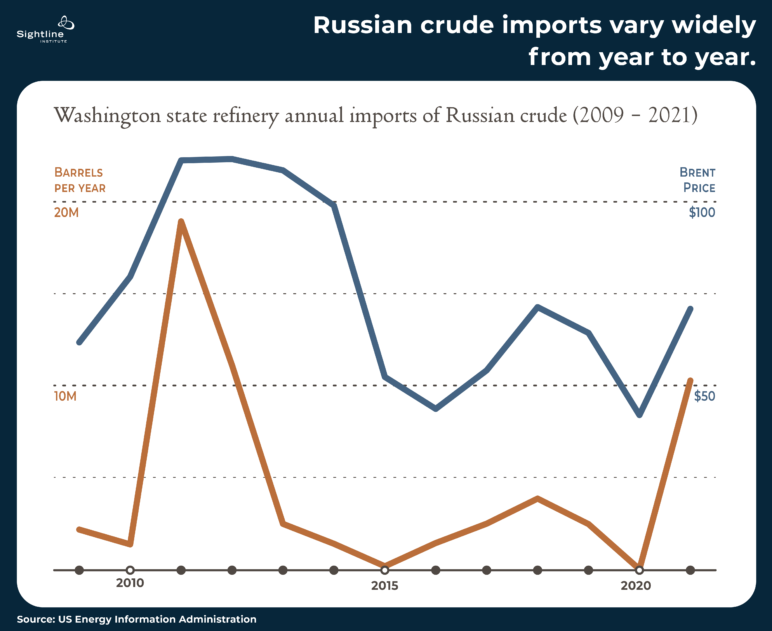Russia’s war of aggression against Ukraine is financed largely from oil and gas exports, predominantly to European countries. But while Cascadia mostly gets our crude from Alaska, Alberta, and North Dakota, our hands are not entirely clean of Russian oil either.
The five oil refineries on Puget Sound that provide almost all of Oregon and Washington’s gasoline, diesel, and other petroleum products import millions of barrels of Russian crude annually. In 2021, they imported more than 10 million barrels of Russian crude. The Tesoro/Marathon Anacortes refinery alone accounted for 8.9 million of those barrels, and according to financial news source S&P Global, this refinery was still importing Russian crude as recently as February 22, just two days before Russia’s invasion began.
At last year’s average world oil price of $71 per barrel, the Northwest’s 2021 imports from Russia cost more than $700 million. Since 2009, the refineries have brought in 58 million barrels of Russian crude at an estimated cost of $5.4 billion.
As a share of the Russian oil wealth that pays for the nation’s military and emboldened Vladimir Putin’s unprovoked invasion of Ukraine, $5.4 billion is slight, but it’s not zero. As a share of the refineries’ total oil supply from 2009 to 2021, 58 million barrels is about 2.1 percent. That seems small, but the region consumes so much oil that even 2.1 percent ends up being a gusher of fossil fuel—and money.
The refineries do not rely on Russian oil equally. Nearly 60 percent of Russian crude imported to Washington went to the Tesoro/Marathon Anacortes refinery, and another 29 percent went to the BP Ferndale refinery. Russian crude made up almost 7 percent of all crude refined at the Tesoro/Marathon Anacortes refinery from 2009 through 2021.

Although Oregon and Washington get 90 percent of their petroleum from these refineries, British Columbia gets only a small share from them. Most of BC’s fuel comes from Alberta, and Canadian refineries have not imported Russia crude at all since 2019. Newly announced Canadian sanctions prohibit further Russian crude imports. Just so, the inland Northwest states of Idaho and Montana depend almost entirely on North American fuel, not waterborne imports. It’s Oregon and Washington that consume the most tanker-carried oil and that therefore import the most from Russia, which accounts for about one-tenth of global supply.
Russian Crude Oil Imports to Puget Sound Refineries, 2009–2021 (thousands of barrels)
| Refinery | Average Annual Russian Crude Imported | Total Annual Crude Refined | Russian Crude Share of Total |
|---|---|---|---|
| Tesoro/Marathon Anacortes | 2,684 | 39,363 | 6.8% |
| BP Ferndale | 1,314 | 80,049 | 1.6% |
| HollyFrontier Anacortes | 232 | 47,950 | 0.5% |
| Phillips 66 Ferndale | 218 | 34,722 | 0.6% |
| US Oil Tacoma | 17 | 13,459 | 0.1% |
| Total | 4,465 | 215,511 | 2.1% |
As of March 4, sanctions have largely excluded Russia’s oil and gas sectors, although many oil-importing nations have started a de facto embargo on Russian oil. Members of the US Congress in both parties are increasingly supportive of a nationwide ban on Russian crude imports.
Sightline is inquiring with the Tesoro/Marathon Anacortes, BP Ferndale, and Phillips 66 Ferndale refineries to learn if they are continuing to import Russian crude and will update this article with what we learn.
Cascadia’s oil imports have generated just a sliver of Russia’s oil revenue, but they are a reminder that our status quo energy economy ties us to the ugly geopolitics of petrostates. The faster Cascadia gets off fossil fuels, the sooner we can stop financially enabling Russian aggression.


